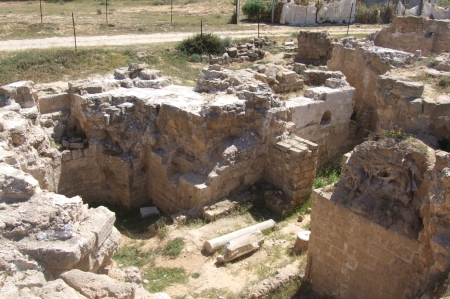
*ancient church and mosque in Gaza City [photo by Emad Badwan]
Oct 22, 2010 (IPS) – Few outside of Gaza would consider its history much beyond the decades of Israeli occupation. But Gaza is a historical treasure house. Many of those treasures are now in Israeli museums, and those that remain are becoming difficult to preserve due to the Israeli siege.
Gaza, set along the historical silk road and on the bridge between Africa and Asia, was host to civilisations, including the Pharaohs, Canaanites, Philistines, Crusaders, Mamluks, Romans and many following. Alexander the Great invaded Gaza; Napoleon Bonaparte passed through.

*photo: Abeer Jamal
“Throughout Gaza, you find pottery and carved columns and capitals, and the remnants of civilisations past, including artifacts from early human presence like the iron and bronze ages,” says Asad Ashoor from the Ministry of Tourism and Antiquities in Gaza.
“There are visible relics in Gaza,” says Ashoor. These have survived civilisations and more recently, Israeli bombings.
In the Deir al Balah region, the vast excavated remains of the Monastery of Saint Hilarion, the first church in Palestine, include surprisingly intact floor mosaics and structural pillars.

*ruins of Hilarion monastery [photo: Abeer Jamal]

*ruins of Hilarion monastery [photo: Abeer Jamal]
In southern Gaza’s Khan Younis, one wall — with an entrance gate and tower — of a Mamluk era inn (“khan”) and fort which served trade caravans stands today in the centre of the city.
Gaza City hosts the Pasha Palace, now a museum, where Napoleon is said to have stayed. The Omari mosque, used today by worshippers, was built on the site of a pagan temple-turned-Byzantine church, and still has a bell tower after it was used as a church again during the Crusader period.
Hammam al-Sammara, the Ottoman bath house, still attracts customers today.
“Recently, workers digging to repair water lines in the Tuffah region of Gaza City discovered an old house from the Mamluk period,” says Abeer Jamal, secretary at the Gaza museum.

*photo: Abeer Jamal
“Above it was cemetery from a later period. But we were not able to excavate because it is an important road for traffic and there are many people living in that area.”
“Roughly eight months ago,” Jammal says, “excavations began on Tel Rafah, an archaeological site from Greek and Roman times, rich with artifacts but in a dangerous area near the Palestinian-Egyptian border. The Israelis dropped leaflets saying not to approach within 300 metres of this specific site,” she says.
But workers continue to excavate, and according to the Ministry of Tourism and Antiquities, have found various important artifacts, including Roman era pots and dishes, pottery and the lid of a coffin from the Byzantine period, and Greek era silver coins.
“The other main discovery was over 40 bronze coins from the Greek era, with the image of Athena, the Emperor, and Greek symbolism including owls, and Greek gods,” says Jammal.
Discoveries and extant antiquities aside, Gaza’s archaeology faces serious obstacles.
Jammal says many of Gaza’s treasures have ended up in museums outside Gaza. “Since my work also entails giving visitors Gaza tours, I’ve met many who say they have seen artifacts like ours in Israeli museums in Tel Aviv and Jerusalem,” she says.
Gerald Butt, in his ‘Life at the crossroads: A History of Gaza’ notes, “The Israel Museum has among its collection a broad-based painted chalice taken from Tell al-Ajjul,” one of Gaza’s most important archeological sites. He later writes, “Pottery manufactured by the Philistines during this period can be seen in the Israel Museum in Jerusalem,” mentioning that Philistine artifacts were largely unearthed in the Wadi Gaza region.
“Most international visitors that enter Gaza enter via Erez and are given by the Israelis ‘a tourist guide to Israeli territory’,” says Abeer Jamal.
Aside from the former problems of looting, and the current Israeli disinformation campaign, archaeology in Gaza faces further obstacles of sporadic Israeli bombings and a lack of specialised equipment and preservation chemicals needed to excavate and maintain relics.
“We urgently need materials, particularly for cleaning and maintaining artifacts,” Jammal says.
Like most daily items Gazans need, the chemicals needed for the preservation of artifacts are banned entry to Gaza under the Israeli-led siege.
“The occupation and siege prevents not only Devcon and Ethanol, the chemicals we need for maintaining our relics, but also outside expertise to help in excavation and restoration,” says the Ministry’s Asad Ashoor.
“Given the circumstances, we do our best to conserve these pieces,” Ashoor says. “Some we can place inside glass tanks, but even these break or crack. And anyway, that doesn’t solve the problem of needing controlled ventilation and temperature.”
According to Ashoor, attempts at gaining United Nations Educational, Scientific and Cultural Organization (UNESCO) approval for historical sites and items have not succeeded.
“We contacted UNESCO, but they have refused to address our archaeological goods,” he says.
“Israel’s goal is a blackout on Palestine’s history and culture,” says Ashoor. “Israel wants outsiders to think only that Gaza is a depressing, dangerous place devoid of culture, history and beauty, and that the main theme here is humanitarian aid.”
Jammal agrees. “This is not just an economical siege, it’s a cultural siege, a siege on everything that is Palestinian.”

*inside one of Gaza’s churches [photo by Emad Badwan]

*Omari mosque, formerly a church [photo: Eva Bartlett]

*Omari mosque detail [photo by Emad Badwan]

*old roofs in Gaza [photo by Emad Badwan]

*the old city, in Gaza City [photo by Emad Badwan]

*old city lanes [photo: Eva Bartlett]

*Khan Younis inn [photo: Abeer Jamal]
Originally published at:
http://ingaza.wordpress.com















